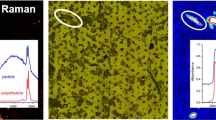Abstract
A standardless method of energy dispersive X-ray fluorescence in conjunction with scanning electron microscopy was used to analyze selected areas of clay-size particles of talc, pyrophyllite, and kaolinite supported by a carbon planchet. Peak intensity ratios of fluorescing elements relative to silicon were converted directly to weight or mole ratios using conversion factors determined theoretically. The conversion factors depend upon particle thickness and mass adsorption coefficients of the sample for the elements analyzed. The effects of particle thickness become significant above ~0.1 μm. Without using particle thickness corrections, the mean molar ratios of metal to Si agreed to within 6.1,0.5, and 9.7% of the theoretical ratios for kaolinite, pyrophyllite, and talc, respectively.
Резюме
Резюме—Использовался бесстандартный метод энергетическо-дисперсионной рентгеновской флуо-ресценции вместе сосканирующей электронной микроскопией для химического анализа выбран-ных мест частиц талька, пирофиллита, и каолинита о размере частиц глины, поддерживаемых угольной основой. Соотношения максимальной интенсивности флуоризуюших элементов по отно-шению к кремнию были превращены непосредственно в весовые или молярные соотношения, используя теоретически определенные факторы. Эти факторы зависят от толщины частиц и коеф-фициентов массовой адсорбции образца для анализированных элементов. Эффекты толщины частиц становятся значительными выше ~0,1 μим. Средние молярные соотношения металла к Si, без использования поправок на толщину частиц, согласовались с теоретическими соотношениями в пределах 6,1, 0,5, и 9,7% для каолинита, пирофиллита и талька, соответственно. [E.C.]
Resümee
Eine standardfreie Methode der energiedispersiven Röntgenfluoreszenz in Verbindung mit Rasterelektronenmikroskopie wurde verwendet, um ausgewählte Bereiche von Talk, Pyrophyllit, und Kaolinit in der Größe der Tonfraktion chemisch zu untersuchen, die auf Kohlenstoffträgern aufgebracht waren. Die Peakintensitätsverhältnisse der fluoreszierenden Elemente im Vergleich zu Silizium wurden direkt in Gewichts- oder Molverhältnisse umgerechnet, wozu theoretisch bestimmte Umrechnungsfaktoren verwendet wurden. Die Umrechnungsfaktoren hängen von der Teilchengröße und von den Masseadsorptionskoeffizienten der Probe für die analysierten Elemente ab. Die Auswirkungen der Teilchendicke wurde über etwa 0,1 μm von Bedeutung. Ohne Korrektur der Teilchendicke weicht das durchschnittliche Molverhältnis Metall/Si für Kaolinit, Pyrophyllit bzw. Talk um etwa 6,1%, 0,5% bzw. 9,7% von den theoretischen Verhältnissen ab. [U.W.]
Résumé
Une méthode sans standard de fluorescence de rayons-X dispersant l’énergie en conjonction avec la microscopie balayante à électrons a été utilisée pour analyser chimiquement des régions choisies de particules de talc, de pyrophyllite, et de kaolinite de taille de l’argile. Les plus hautes proportions d’intensité d’éléments fluorescents relativement à la silice ont été convertis directement en proportions de poids, ou molaires en utilisant des facteurs de conversions déterminés théoriquement. Les facteurs de conversion dépendent de l’épaisseur et des coefficients d’adsorption de masse de l’échantillon pour les éléments analysés. Les effets de l’épaisseur de la particule devenaient significatifs au dessus d’ ~0,l μm. Sans utiliser les corrections pour l’épaisseur de particule, les proportions molaires moyennes du métal à la silice s’accordaient à 6,1, 0,5, et 9,7% près avec les proportions théoriques pour la kaolinite, la pyrophyllite, et le talc, respectivement. [D.J.]
Similar content being viewed by others
References
Berkheiser, V. E. and Monsees, M. B. (1982) Dispersion of clays on graphite supports for X-ray microprobe analysis: Soil Sci. Soc. Amer. J. 46 (in press).
Brindley, G. W. and Wardle, R. (1970) Monoclinic and triclinic forms of pyrophyllite and pyrophyllite anhydride: Amer. Minerai. 55, 1259–1272.
Cliff, G. and Lorimer, G. W. (1975) The quantitative analysis of thin specimens: J. Microsc. 103, 203–207.
Colby, J. W. (1968) Quantitative microprobe analysis of thin insulating films: Adv. X-Ray Anal. 11, 287–305.
Duncomb, P. (1962) Enhanced X-ray emission from extinction contours in a single-crystal gold film: Phil. Mag. 7, 2101–2105.
Goldstein, J. I. and Colby, J. W. (1975) Special techniques in the X-ray analysis of samples: in Practical Scanning Electron Microscopy, J. I. Goldstein and H. Yakowitz, eds., Plenum Press, New York, 435–490.
Goldstein, J. I., Costley, J. L., Lorimer, G. W., and Reed, S. J. B. (1977) Quantitative X-ray analysis in the electron microscope: SEM 197. 1, 315–325.
Hirsch, P. B., Howie, A., and Whelan, M. J. (1962) On the production of X-rays in thin metal films: Phil. Mag. 7, 1095–2100.
König, R. (1976) Quantitative X-ray microanalysis of thin foils: in Electron Microscopy in Mineralogy, H. R. Wenk, ed., Springer-Verlag, New York, 526–536.
McCrary, H. J., Singman, L. V., Ziegler, L. H., Looney, L. D., Edmonds, C. M., and Harris, E. (1971) K-fluorescent X-ray relative intensity measurements: Phys. Rev. A4, 1745–1750.
Namae, Takao (1975) A method for quantitative analysis for thin specimens by energy dispersive spectrometer fitted to transmission electron microscope: J. Electron Microsc. 24, 1–6.
Philibert, J. and Tixier, R. (1975) Electron probe microanalysis of transmission electron microscope specimens: in Physical Aspects of Electron Microscopy and Microbeam Analysis,. B. Siegel and D. R. Beaman, eds., Wiley, New York, 333–354.
Reed, S. J. B. (1975) Electron Microprobe Analysis. Cambridge University Press, New York, 308–310.
Slivinsky, V. W. and Ebert, P. J. (1972) Kß/K. X-ray transition-probability ratios for elements 18 « Z ss 39: Phys. Rev. A5, 1581–1586.
Stemple, I. S. and Brindley, G. W. (1960) Structural study of talc and talc-tremolite relations: J. Amer. Ceram. Soc. 43, 34–42.
Zaluzec, N. J. (1978) An analytical electron microscope study of the omega phase transformation in a zirconium-niobium alloy: Oak Ridge National Laboratory Report ORNL/TM6705, National Technical Information Service, Spring-field, Virginia, 31–141 pp.
Zaluzec, N. J. (1979) Quantitative X-ray microanalysis: Instrumental considerations and applications to materials science: in Introduction to Analytical Electron Microscopy, J. J. Hren, J. I. Goldstein, and D. C. Joy, eds., Plenum Publishing Corp., New York, 121–167.
Author information
Authors and Affiliations
Additional information
Contribution from the Agricultural Experiment Station, University of Florida, Journal Series No. 3342.
Rights and permissions
About this article
Cite this article
White, G.N., Berkheiser, V.E., Blanchard, F.N. et al. Thin-Film Analysis of Clay Particles Using Energy Dispersive X-Ray Analysis. Clays Clay Miner. 30, 375–382 (1982). https://doi.org/10.1346/CCMN.1982.0300508
Received:
Accepted:
Published:
Issue Date:
DOI: https://doi.org/10.1346/CCMN.1982.0300508




